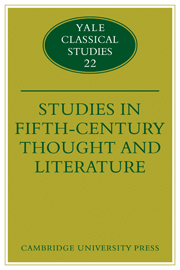Book contents
- Frontmatter
- Contents
- Tribute to Harry Mortimer Hubbell
- Preface
- The Socratic self as it is parodied in Aristophanes' Clouds
- The relativism of Protagoras
- Thucydides' historical perspective
- The psychoanalysis of Pentheus in the Bacchae of Euripides
- Aetiology, ritual, charter: three equivocal terms in the study of myths
- Divine and human action in Sophocles: the two burials of the Antigone
- Menander's Samia in the light of the new evidence
- The choral odes of the Bacchae of Euripides
- Stylistic characterization in Thucydides: Nicias and Alcibiades
- Scientific apparatus onstage in 423 B.C.
- Phaedra and the Socratic paradox
- Euripides' Iphigenia in Aulide 1–163 (in that order)
- Notes on Sophocles' Trachiniae
Menander's Samia in the light of the new evidence
Published online by Cambridge University Press: 10 January 2011
- Frontmatter
- Contents
- Tribute to Harry Mortimer Hubbell
- Preface
- The Socratic self as it is parodied in Aristophanes' Clouds
- The relativism of Protagoras
- Thucydides' historical perspective
- The psychoanalysis of Pentheus in the Bacchae of Euripides
- Aetiology, ritual, charter: three equivocal terms in the study of myths
- Divine and human action in Sophocles: the two burials of the Antigone
- Menander's Samia in the light of the new evidence
- The choral odes of the Bacchae of Euripides
- Stylistic characterization in Thucydides: Nicias and Alcibiades
- Scientific apparatus onstage in 423 B.C.
- Phaedra and the Socratic paradox
- Euripides' Iphigenia in Aulide 1–163 (in that order)
- Notes on Sophocles' Trachiniae
Summary
In June 1969, the Bodmer Library at Cologny, near Geneva, brought out a photographic facsimile and a transcription of those pages of the codex containing Menander's Dyskolos which contain large fragments of the Samia and Aspis of the same author (Papyrus Bodmer XXV and XXVI). In July Dr Colin Austin, who has collaborated with Professor Rodolphe Kasser in the preparation of these volumes, published a critical edition of both works; a commentary in a separate volume soon followed (Menandri Samia et Aspis, I et II, in the series Kleine Texte für Vorlesungen und Übungen, Berlin, Walter de Gruyter, 1969, 1970). The reader of this article will be well advised to have in hand the facsimile and Dr Austin's text, or at any rate the latter. In it I am concerned not to discuss the critical problems in which the text abounds, but to attempt a general survey of the Samia, offering at the same time a translation of most of the new material. For detailed explanation of the text, I refer the reader to Dr Austin's work. 341 lines (or parts of lines) of this play are contained in the famous Cairo papyrus published by Lefèbvre in 1905, together with one line known from a quotation. We now have 738 lines altogether, and it seems likely that about 158 lines are missing.
In order to evaluate our new gains we may begin by recapitulating what was known about the play when we had only the portion of the text in Cairo.
- Type
- Chapter
- Information
- Studies in Fifth Century Thought and Literature , pp. 119 - 144Publisher: Cambridge University PressPrint publication year: 1972

